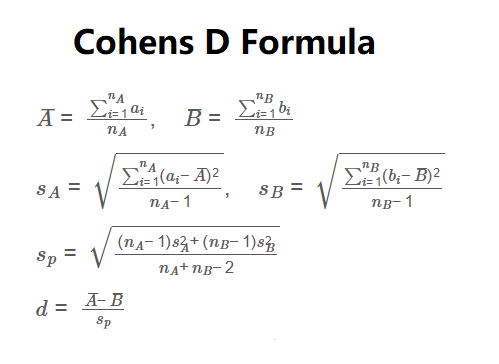1. What is the Cohen's D Calculator?
Definition: The Cohen's D Calculator computes Cohen’s D, a measure of effect size that quantifies the standardized difference between the means of two datasets, adjusted for their pooled standard deviation.
Purpose: This tool is used in statistical analysis to assess the magnitude of differences between two groups, commonly in psychology, education, and medical research to evaluate treatment effects or group differences.
2. How Does the Calculator Work?
The calculator uses the following formulas:
\( \bar{A} = \frac{\sum_{i=1}^{n_A} a_i}{n_A}, \quad \bar{B} = \frac{\sum_{i=1}^{n_B} b_i}{n_B} \)
\( s_A = \sqrt{\frac{\sum_{i=1}^{n_A} (a_i - \bar{A})^2}{n_A - 1}}, \quad s_B = \sqrt{\frac{\sum_{i=1}^{n_B} (b_i - \bar{B})^2}{n_B - 1}} \)
\( s_p = \sqrt{\frac{(n_A - 1)s_A^2 + (n_B - 1)s_B^2}{n_A + n_B - 2}} \)
\( d = \frac{\bar{A} - \bar{B}}{s_p} \)
Where:
- \( \bar{A}, \bar{B} \): Means of datasets A and B;
- \( s_A, s_B \): Standard deviations of datasets A and B;
- \( s_p \): Pooled standard deviation;
- \( n_A, n_B \): Sizes of datasets A and B;
- \( a_i, b_i \): Data points in datasets A and B;
- \( d \): Cohen’s D.
Steps:
- Enter comma-separated numbers for datasets A and B.
- Calculate the mean of each dataset by summing the values and dividing by the number of data points.
- Compute the sample standard deviation for each dataset using the formula for sample standard deviation.
- Calculate the pooled standard deviation by combining the variances of both datasets.
- Compute Cohen’s D by dividing the difference in means by the pooled standard deviation.
- Display results formatted to four decimal places or scientific notation for small values.
3. Importance of Cohen's D
Cohen’s D is essential for:
- Effect Size Measurement: Quantifies the magnitude of differences between groups, beyond statistical significance.
- Research Applications: Helps compare treatment effects or group differences in fields like psychology and medicine.
- Interpretation: Provides a standardized metric (e.g., d ≈ 0.2 is small, 0.5 is medium, 0.8 is large) to interpret practical significance.
4. Using the Calculator
Example: Calculate Cohen’s D for Dataset A: [5, 9, 3, 45, 8] and Dataset B: [8, 9, 12, 15, 7].
- Input: Dataset A: 5,9,3,45,8; Dataset B: 8,9,12,15,7
- Mean A: \( \frac{5+9+3+45+8}{5} = 14 \)
- Mean B: \( \frac{8+9+12+15+7}{5} = 10.2 \)
- Std Dev A: \( \sqrt{\frac{(5-14)^2 + (9-14)^2 + (3-14)^2 + (45-14)^2 + (8-14)^2}{5-1}} \approx 17.4929 \)
- Std Dev B: \( \sqrt{\frac{(8-10.2)^2 + (9-10.2)^2 + (12-10.2)^2 + (15-10.2)^2 + (7-10.2)^2}{5-1}} \approx 3.2711 \)
- Pooled Std Dev: \( \sqrt{\frac{(5-1)(17.4929)^2 + (5-1)(3.2711)^2}{5+5-2}} \approx 12.5837 \)
- Cohen’s D: \( \frac{14 - 10.2}{12.5837} \approx 0.3020 \)
- Result: Mean A: 14.0000, Mean B: 10.2000, Std Dev A: 17.4929, Std Dev B: 3.2711, Pooled Std Dev: 12.5837, Cohen’s D: 0.3020
5. Frequently Asked Questions (FAQ)
Q: What is Cohen’s D?
A: Cohen’s D is a measure of effect size that quantifies the standardized difference between the means of two datasets, adjusted for their pooled standard deviation.
Q: How do you interpret Cohen’s D?
A: A value of ~0.2 indicates a small effect, ~0.5 a medium effect, and ~0.8 a large effect, though interpretation depends on context.
Q: Why is Cohen’s D useful?
A: It provides a standardized way to assess the practical significance of differences between groups, useful in research to evaluate interventions or group differences.
 Home
Home
 Back
Back
